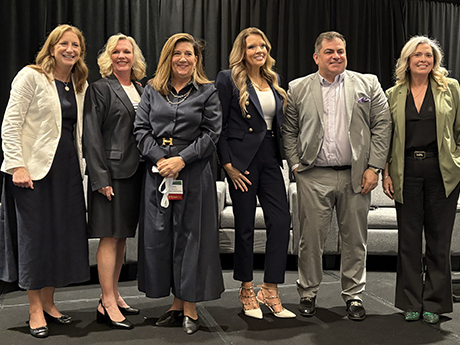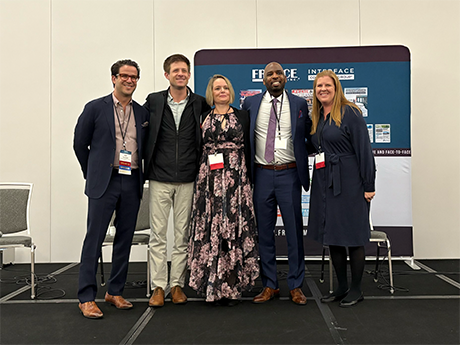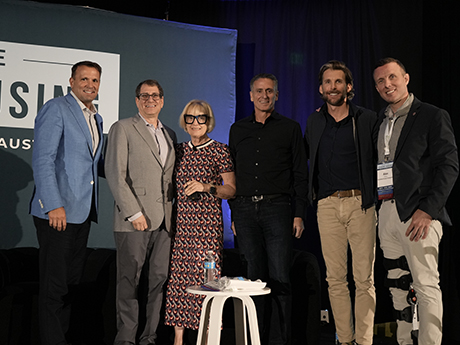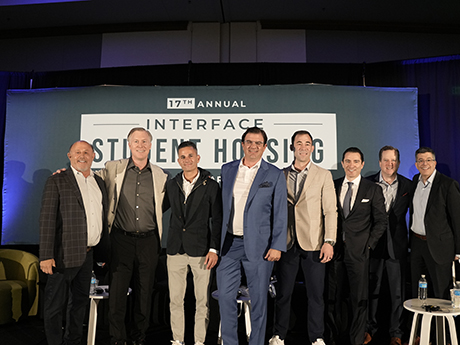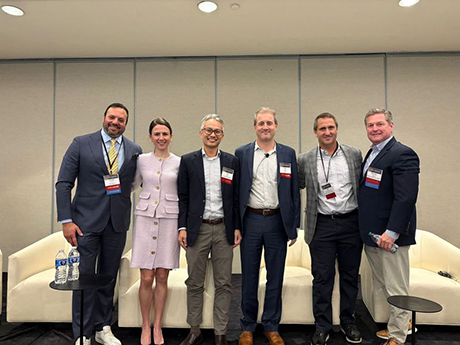DALLAS — What’s in a name? Plenty, according to the industry professionals that operate and market active adult communities. Jane Arthur Roslovic, co-founder and CEO of Treplus Communities, says that “if anybody called [her] a senior” she’d “smack them.” Roslovic’s quip came during a panel discussion — titled “Operating and Marketing: Best Practices in Lease-Up, Sales and Programming” — at the 5th annual InterFace Active Adult conference. The daylong event took place Wednesday, May 7, at The Westin Las Colinas in Dallas. Editor’s note: InterFace Conference Group, a division of France Media Inc., produces networking and educational conferences for commercial real estate executives. To sign up for email announcements about specific events, visit www.interfaceconferencegroup.com/subscribe. Roslovic and her fellow panelists argued that the same reluctance to be branded as a “senior” extends to prospective residents of active adult communities. The key to attracting and retaining residents, the panelists insisted, is to not only provide excellent product but also understand and cater to the public’s perception of age-restricted properties. Active adult communities are age-eligible, market-rate multifamily properties with enhanced lifestyle programming, according to the National Investment Center for Seniors Housing & Care (NIC). Unlike independent living communities, active adult properties do not …
Conference Coverage
ATLANTA — Affordable housing is facing a tumultuous second half of the year. Tariffs on building materials such as lumber, steel and aluminum are slowing development activity as they elevate construction costs. Investment sales are also likely to be impacted by unstable economic conditions in the affordable housing sector, where many transactions are conducted within a limited budget due to the nature of income restrictions for renters. Amid high costs and trade uncertainty, many investors are making the decision to stay on the sidelines or invest in markets with more stable conditions. Editor’s note: InterFace Conference Group, a division of France Media Inc., produces networking and educational conferences for commercial real estate executives. To sign up for email announcements about specific events, visit www.interfaceconferencegroup.com/subscribe. “The most experienced, best qualified buyers are being careful about what they purchase,” said Kyle Shoemaker, a managing director at Affordable Housing Investment Brokerage. The Downers Grove, Illinois-based company arranges acquisitions and dispositions of Section 8, Section 42, low-income housing tax credit (LIHTC) and tax credit housing. “The affordable housing sector was heated in 2021,” Shoemaker continued. “At that point in time, we were getting more calls than ever from multifamily investors who were interested in entering the affordable …
By Katie Sloan AUSTIN, TEXAS — The ‘State of the Industry’ panel at the 17th annual InterFace Student Housing conference held more of a trepidatious tone than heard in recent years. While pre-leasing levels and rental rates are still above historical norms, the industry is seeing a slight deceleration in pre-leasing speed and rate growth, leading some to question what the industry has in store for the year ahead. The discussion — held on April 10 in Austin, Texas — was moderated by Alex O’Brien, CEO with Cardinal Group. The best way to characterize the industry this year is hesitant according to Ryan Lang, executive vice chairman with Newmark, who believes investor reluctance is largely due to pre-leasing numbers falling a couple of points behind levels seen at this time last year. Still, levels are trending far ahead of pre-leasing levels seen in 2019, lending to confidence overall in the sector. Editor’s note: InterFace Conference Group, a division of France Media Inc., produces networking and educational conferences for commercial real estate executives. To sign up for email announcements about specific events, visit www.interfaceconferencegroup.com/subscribe. “The past two years were unprecedented from a leasing perspective with properties leasing up the fastest and with the highest rents growths …
By Katie Sloan AUSTIN, TEXAS — The 17th annual InterFace Student Housing conference, held April 9-11 at the JW Marriott in Austin, Texas, saw more than 1,500 student housing industry executives gather for educational sessions and networking. The conference’s first full day kicked off on April 10 with the ‘Power Panel,’ which brought together a group of high-level executives from several of the top companies in the sector to discuss their outlook for the year ahead. Moderator Peter Katz, executive managing director with Institutional Property Advisors, began the discussion by highlighting a few growing concerns in the current economic environment. Chief among them were the potential impact of global tariffs on equity and development in student housing and the possibility of an economic slowdown or even an impending recession. Editor’s note: InterFace Conference Group, a division of France Media Inc., produces networking and educational conferences for commercial real estate executives. To sign up for email announcements about specific events, visit www.interfaceconferencegroup.com/subscribe. Still, the student housing sector has proven time and time again that it is a resilient asset class. “If we look back at the global financial crisis and COVID-19 pandemic, we’ve witnessed that the student housing sector is pandemic- and recession-resistant,” said Katz. “Institutional …
Foundation Has Been Laid for Seniors Housing Investment Sales to Flourish in 2025, Says InterFace Panel
by John Nelson
LOS ANGELES — Dan Baker, director of capital markets for JLL, says the seniors housing and care industry doesn’t need to speculate on whether the market rebound is real or perceived because the numbers tell the story. “I think last year saw the most announced seniors housing transactions ever in a calendar year, not necessarily the most dollar volume,” said Baker during a recent investment panel discussion at InterFace Seniors Housing West in Los Angeles. Baker cited the lack of larger portfolios trading hands as the reason for the modest dollar volume in transaction activity in 2024. Editor’s note: InterFace Conference Group, a division of France Media Inc., produces networking and educational conferences for commercial real estate executives. To sign up for email announcements about specific events, visit www.interfaceconferencegroup.com/subscribe. According to research firm MSCI, property and portfolio sales in the seniors housing and care space totaled $13.2 billion in 2024 compared with $10.9 billion in 2023, a year-over-year increase of 21 percent. That’s still far below the $20.7 billion in deal volume notched in 2021. The data is based on independent reports of sales $2.5 million and above. One compelling trend noted by Baker is the tremendous growth in net operating …
By Taylor Williams AUSTIN, TEXAS — On the surface, Austin has everything that expanding retail and restaurant operators could possibly want: youth, density, culture, high-paying jobs. Yet when these users begin scouting and diving into the state capital’s retail real estate market, they often find that entering or expanding there is much easier said than done. Skyrocketing home prices, increased vehicular congestion and limited infrastructure outside the urban core are just the most visible ways in which Austin has been somewhat victimized by its own torrid growth over the past 10 to 15 years. And each of those variables factors into retail site selection and contributes to the challenges of adding new retail and restaurant space to the market. Editor’s note: InterFace Conference Group, a division of France Media Inc., produces networking and educational conferences for commercial real estate executives. To sign up for email announcements about specific events, visit www.interfaceconferencegroup.com/subscribe. Simply put, if there are no rooftops, roads, parking spaces and utilities, there can be no new retail development. Such is the story in some of Austin’s more remote suburbs, though few doubt that those preliminary requirements for retail growth will eventually be delivered. But there is also the issue of raw …
By Taylor Williams SAN ANTONIO — Automotive parts manufacturers and data center operators both represent major sources of demand for industrial space in San Antonio, as well as major consumers of electrical resources. Both sets of users are increasingly prioritizing access to cheap, abundant electricity in their site selection and other real estate decisions. But that’s about where their similarities end. For the automotive industry has been a source of job growth and retention in the San Antonio area for decades, whereas data centers are a relatively new phenomenon that offer minimal contributions to local employment. And in between the two on the spectrum of industrial end users are third-party distribution and logistics companies, which really represent the market’s bread-and-butter tenant. But these groups typically don’t have such taxing power demands. Editor’s note: InterFace Conference Group, a division of France Media Inc., produces networking and educational conferences for commercial real estate executives. To sign up for email announcements about specific events, visit www.interfaceconferencegroup.com/subscribe. For data center developers and users, the need and demand for affordable, plentiful power is nothing new. And the fact that Texas has long had its own deregulated power grid has contributed mightily to the state landing many of those …
By Taylor Williams DALLAS — As is the case for many commercial asset classes and markets in 2025, there is an expectation of elevated deal volume for investment sales of affordable housing properties in Texas. But brokers in that space caution that the rebound will likely be marginal and is not necessarily indicative of ideal market conditions taking hold. A quintet of panelists broke down this notion and others at the InterFace Texas Affordable & Workforce Housing conference on Feb. 13 at the Westin Galleria Dallas hotel. Mary Ann Bennett, senior managing director at BBG Real Estate Services, moderated the discussion on investment sales activity. Editor’s note: InterFace Conference Group, a division of France Media Inc., produces networking and educational conferences for commercial real estate executives. To sign up for email announcements about specific events, visit www.interfaceconferencegroup.com/subscribe. Panelist Michael Furrow, senior vice president of affordable housing at commercial finance firm BWE, took the audience of 200-plus back in time to illustrate just how quiet the past two years had been. He did so by providing statistics on affordable housing sales for Dallas-Fort Worth (DFW) between 2021 — when multifamily rents and sales prices were peaking across the board — and 2024, when they …
Gerald Divaris, chairman and CEO of Divaris Group of Companies and a panelist at last week’s Entertainment Experience Evolution (EEE) conference, produced by France Media’s Shopping Center Business and InterFace Conference Group, has a Shakespearean take on today’s retail environment. It’s that all the (retail) world’s a stage. “Retail is essentially entertainment,” he told a crowd of 500 attendees during the Leading Retail Landlords Panel at EEE, which was held Feb. 25-26 at the J.W. Marriott LA Live. “Otherwise, you’d be buying on Amazon.” Editor’s note: InterFace Conference Group, a division of France Media Inc., produces networking and educational conferences for commercial real estate executives. To sign up for email announcements about specific events, visit www.interfaceconferencegroup.com/subscribe. Divaris expanded upon this notion, citing that even supermarkets have entertaining “stations,” TJ Maxx provides the opportunity to treasure hunt and Barnes & Noble has made a major comeback by doing little more than allowing guests to thumb through books. Panel moderator Nick Egelanian, president of SiteWorks, noted much of the current retail experience can be divided into two categories, though it may not be an even split. There are the items consumers want to buy quickly and easily (and arguably cheaply) online, and …
InterFace Panel: Slow and Steady Wins the Race for Student Housing Preleasing, Rent Growth in 2025
by John Nelson
CHARLOTTE, N.C. — As the clock struck midnight on New Year’s Eve, the 2025-2026 academic year moved further into focus. What can the industry expect to see this year from a preleasing perspective? Are rents expected to keep growing? And by how much? All of these questions and more were discussed during a kick-off panel at the 2024 LeaseCon/TurnCon conference by InterFace Conference Group, which took place this past December in Charlotte. As of Dec. 3, student housing properties across the country were 36.6 percent preleased on average — a 1.3 percent decline from rates seen at the same time in 2023, according to moderator Charlie Matthews, founder and CEO of data provider College House. Editor’s note: InterFace Conference Group, a division of France Media Inc., produces networking and educational conferences for commercial real estate executives. To sign up for email announcements about specific events, visit www.interfaceconferencegroup.com/subscribe. Of markets across the United States, the Southeast led the way with the highest preleasing percentage at 43.5 percent. Asking rents have congruently grown by 4.9 percent across the country as of early December, according to Matthews, with average rents at $990. Leading the way in rent growth for the 2025-2026 academic year …


